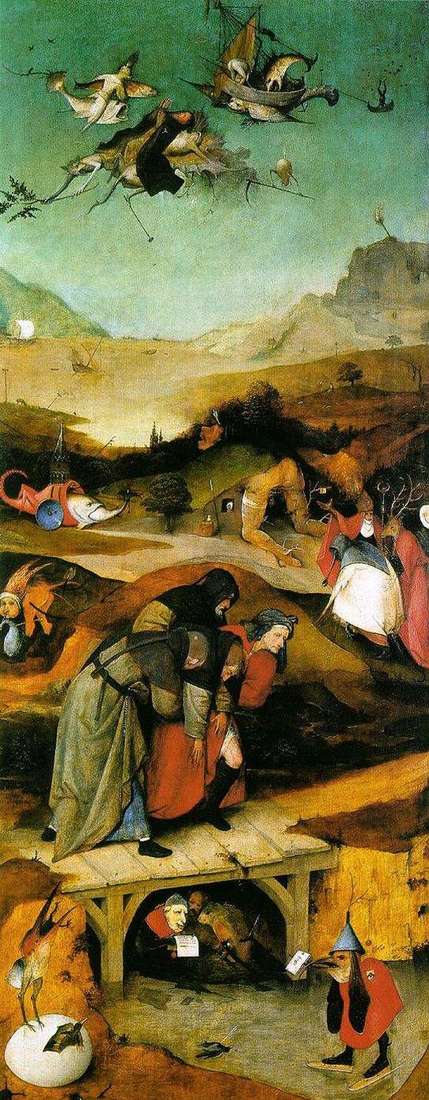
The painting “The Flight and Fall of St. Anthony” is the left wing of the altar “The Temptation of St. Anthony” and tells of the struggle of the saint with the Devil. To this theme, the artist repeatedly returned to his work. Saint Anthony is an instructive example of how to resist terrestrial temptations, to be alert all the time, not to take for truth all that seems, and to know that seduction can lead to God’s curse. When Antony creates a prayer, demons attack him, beat him up, lift him high into the air and throw him to the ground.
The main character in the left wing of the triptych is the saint himself, whom the monastic brothers of the Order of St. Anthony raise after falling from the sky. As the fourth person in this group, Bosch, according to some assumptions, portrayed himself. The plot is interpreted in accordance with the text “Lives of St. Anthony” by Athanasius of Alexandria and with the “Golden Legend”. In the upper part of the door, Saint Anthony is depicted with prayer folded hands, a sign of the steadfastness of his faith. He is carried to the sky by clouds of winged demons, among them – a flying toad, a fox with a whip. The saint does not pay attention to his tormentors and does not see that he is also threatened by a water man, armed with a fish – a symbol of sin.
In the landscape of the middle part of the wing, the fantastic is connected to the real one – the hillside is the back of a character standing on all fours, and the grass is his cloak. His back rises above the entrance to the cave, which some researchers consider a haven of the saint, and others – a public house. To the ambiguous cave is sent a group of demons, clearly representing a parody of a religious procession. At the head of her demon in the miter and the cloak of the priest, next to him is a deer in a red cloak. Traditionally, a deer is a symbol of the faithfulness of the soul in Christianity, here its image is a deliberate blasphemy.
In the lower part under the bridge, through an ice-covered stream, the devil’s gang listens to a monk reading an illegible letter. This group is approached by a bird on skates, carrying in the beak a message with the inscription “fat” – a mockery of the priests who profit on the trade in indulgences. According to a slightly different interpretation in the picture, three monks help St. Anthony to reach the cell after a grueling battle with the Devil, which raised him into the air – this scene is depicted above, against the sky. Bosch violates the established canons describing the return of the saint to the earth after the test, but this iconographic freedom is lost in the original concept of Temptation he created.
A strange construction with a human figure standing on all fours, the procession of grotesque characters approaching it, the figures of fantastic creatures to the left of the holy, awesome bird in the foreground, skating – all this, according to the artist’s intention, should illustrate the temptations to which Saint Anthony. So, a piece of paper with the inscription “lazy”, which the bird holds in its beak, symbolizes the sin of idleness.


 (2 votes, average: 3.50 out of 5)
(2 votes, average: 3.50 out of 5)